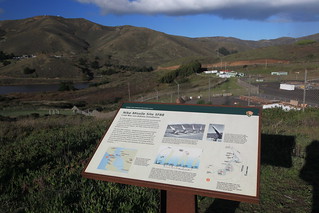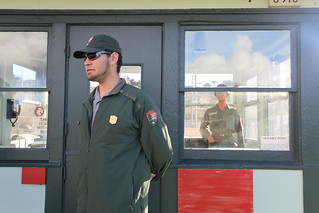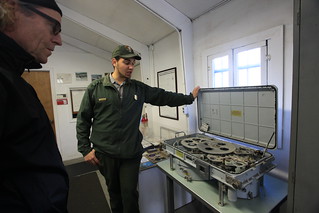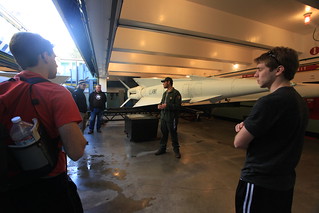On December 12, a National TLC Service worker visited SF-88, the only fully restored Nike missile facility in the United States. Operated by the National Park Service in conjunction with a corps of volunteers, the facility and small museum are part of the Golden Gate National Recreation Area in the Marin Headlands near San Francisco. Tours are offered three afternoons per week by park rangers and on the first Saturday of every month by volunteers. Like many Cold War heritage sites, emphasis is placed on weapons technology in ways that skirt persistent political questions about the period. At SF-88, the Nike weapons system is presented in seeming paradox: an antiquated but still fetishized technology whose accuracy and destructive power continue to inspire awe. Slice of life anecdotes and a physically immersive tour experience humanize what might otherwise be a dry recitation of weapons systems names and numbers. But despite the uncanny effect of the time-capsule military installation, the tour’s insistence on political neutrality privileges a techno- and military-centric narrative of the Cold War. In the end, the powerful experience of ‘going underground’ is a momentary chill that ultimately makes easier the meanings and consequences of atomic weapons no easier to grasp.
The Nike missiles in Marin were among the first guided, surface-to-air missiles to be deployed on a mass basis. From 1954 through 1974, the US operated a total of 280 Nike missile facilities across the country, ringing major cities and strategic military installations, as a last line of defense against Soviet planes bearing nuclear bombs. The first generation Nike missiles – the “Ajax” – were equipped with high-impact explosives, while the second generation, the “Hercules” were capable of carrying nuclear payloads. San Francisco – heavily fortified at least since the Civil War – was ringed by 24 Nike sites. New York, a city ten times the size, was protected by 20. Each installation consists of three sites spread over at least a mile: an integrated fire control center with radar arrays and guidance systems; a launch area housing the missiles; and barracks and support facilities for the crew. While the precise locations of nuclear-equipped missiles was a state secret, a weapons system this extensive was impossible to keep under wraps. The Army, which oversaw Nike operations, produced films designed to impress the public about the sophistication of this “shield that will protect us all.”
These films are among the artifacts that greet visitors at the small museum in the former administration building at the Nike site in the Marin Headlands. The room is crammed with missile ephemera: mission and squadron badges, control consoles, Nike contractor newsletters, uniforms and gas masks, a partially dismantled Ajax body, and inspirational posters (“If it flies, it dies.”). Taking in the nostalgic bric-a-brac is overwhelming; displays are anachronistic and idiosyncratic, probably assembled from the personal collections of the Nike veterans who first approached the Park Service to open the site. A few photographs of recent classes graduating from the Department of Energy’s Nuclear Weapons Intern Program exist side-by-side with once-official diagrams of world surface-to-air missiles labeled “United States,” “Free World,” and “Soviet Union.” The graduation photographs are one reminder that the Nike program’s closure merely closed one chapter in the very much ongoing story of nuclear weapons.
National Park Service Ranger Brian Powers greeted the handful of visitors promptly at the top of the hour, his green uniform echoing the Cold War-era Army work uniforms worn by the mannequins posting sentry by the entrance. Powers, who appeared to have been born in the waning years of the Cold War, delivered a summary of the Nike program and an outline of the deterrence doctrine in an incongruous surfer drawl. He seemed justifiably proud that he’d spent a year preparing tour guide training materials and formalizing the interpretive program at SF-88, and he was well in command of the technical details and the history of weapons system evolution. Demonstrating a component of the once room-sized analog computer that controlled missile trajectories, Powers announced that a typical iPhone has vastly greater computational power. On cue, a visitor produced one from his pocket, the palm-sized black screen contrasting sharply with the suitcase of gears and pins. Yet comparing the guided missile system unfavorably to a cell phone did not rob it of its power; rather, the finely-turned circuits that could have triggered a nuclear war become more awesome through their machine-age limitations.
Such meditations about variations on the technological sublime were not the point of the tour, however. Leaving the museum, Powers explained the radar system and battery control trailer that had been relocated from the former command station on a ridge across the valley. Details about the power of the radar array (200 kilowatts), missile range (50 miles for Ajax, 110 miles for Hercules), and the guidance process flew by, and it was hard to formulate questions that could keep up with the flow of information. I asked about any environmental consequences of the enormous number of Nike sites across the country. Powers replied that there was some reason to believe the acquisition radar arrays, with beams up to 6 megawatts, had killed thousands of migrating birds, essentially cooking them midair with the power equivalent of 8,000 microwave ovens.
The underground tour of the missile storage facility is usually identified as the highlight of the tour experience in online reviews, and it’s unsettling to descend into the bunker, flick on the flourescents, and stand face to face with a half-dozen disarmed nuclear weapons. The technological sublime is at work here, along with the phallic power of these long, sleek missiles, but so is the anachronistic quality of the museum. The underground bunker is pristine, so effectively restored and maintained that with very little imagination one could imagine a crew of men much like the ranger called to lift the missiles to the surface in a timed drill. Yet the bunker is a space devoid of computers—those devices that embody precision and professionalism today—and instead runs on cogs and visible conduit (not to mention the muscle of the missile crew). The effect is the bunker seems less a time capsule than a zone of suspended animation, a place where the Cold War isn’t neither fully present nor completely past.
The unsettling quality of the bunker could open up discussions about the unfinished business of the Cold War—about the effectiveness of deterrence, about the wisdom of the lopsided investment in defense, about the cultural impacts of militarization and secrecy, about the long-term environmental and health effects of bombs and their infrastructures. But the National Park Service’s apparent desire to present ‘just the facts’ in a way that would allow the visitor to draw his own conclusions limited the possibility that any conclusions would be drawn at all—let alone ones that challenged preconceptions. Unspoken questions hung in the air at several points in the tour, while some answers begged for follow up discussion. When one of my fellow tourists asked about the effect of detonating a bomb twice the power of Fat Man in the air, one hundred miles off the coast of San Francisco. Powers shrugged and said, “It would have meant the start of World War III, so that would be the least of their worries.”
As we climbed up the stairs to the angled December sunlight, I found myself thinking that the Park Service’s commitment to neutrality forced an interpretive framework that was not neutral and only barely interpretive. Reciting technical details of weapons systems and contextualizing them in terms of military doctrine risked recapitulating the mainstream narrative of Cold War necessity. But adding anything to that narrative courts controversy—something government agencies with precarious budgets are careful to avoid. But the absence of controversy—in San Francisco, no less—leaves too much out of the story. Moreover, it makes it difficult for visitors to assemble and reflect upon the many threads of information and impressions that almost all of us arrived with. I asked the ranger who comes and asks for a tour; he answered that it’s a diverse group that includes Nike veterans and school groups, hikers and international visitors, history buffs and families. Surely these people would have a lot to say to one another, but it is beyond the scope and ability of the National Park Service to facilitate these conversations. It seems vital that someone do it, however, if the Cold War is not to recede in the public imagination into analog-era curiosity.






